Archive for the 'Fruit' Category
Some of my fruit trees are already blooming in late February, including my nectarine, almond, and mutli-grafted pluot, which is shown below.
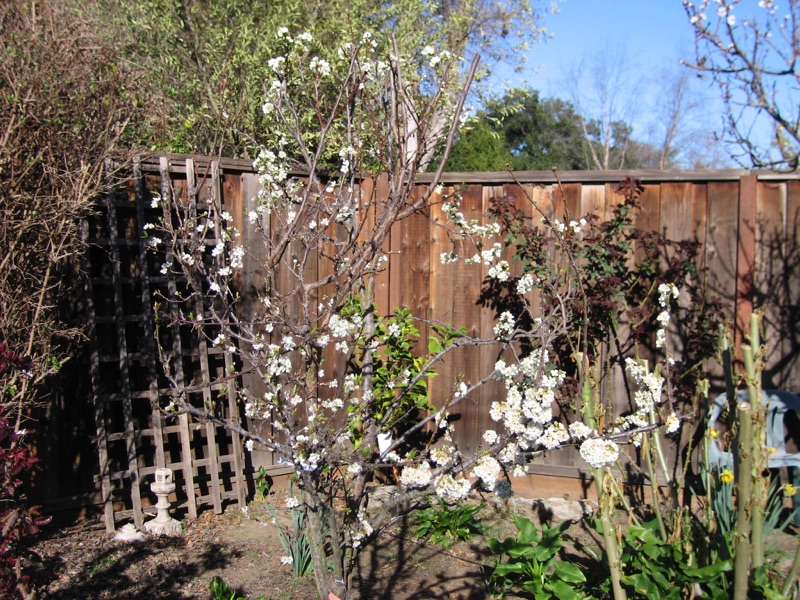
The Dabble Dandy pluot graft is full of blossoms after having set no fruit last year (lower right in picture). The blossoms of Dabble Dandy and Flavor Supreme pluots are overlapping with the later blooming Flavor Queen and Flavor King pluot grafts (upper left and right, respectively), which need to be cross-pollinated by Supreme and Dandy. Last year, the King/Queen bloom times did not overlap for very long with Dandy/Supreme, and none of the 4 varieties set as many fruits as previous years. Luckily, the weather for the most part has been sunny and dry, which should be great for pollination.
This year, I set out sugar snap pea seeds in the ground early on Feb. 2 (Cascadia, Sugar Ann, Sugar Lace, and Super Sugar Snap varieties). I planted left over seeds from last year. Most of the seeds have sprouted. I have the bed covered with mosquito netting that is supported by sticks to keep the seedlings from being eaten. A part of this bed (with the netting off) is shown below.
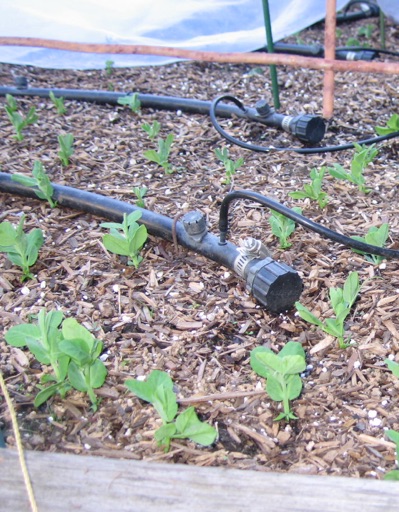
I planted these same 4 varieties last year. The Sugar Anns were the first to produce peas, in late April. Cascasdia produced the most peas, throughout May until mid-June. They were also the most tasty and my favorite overall. The other two varieties also produced well (mid-May to mid-June). Below is a picture of the 3 dwarf varieties (Sugar Ann, Cascadia, Sugar Lace) last Apr. 27.
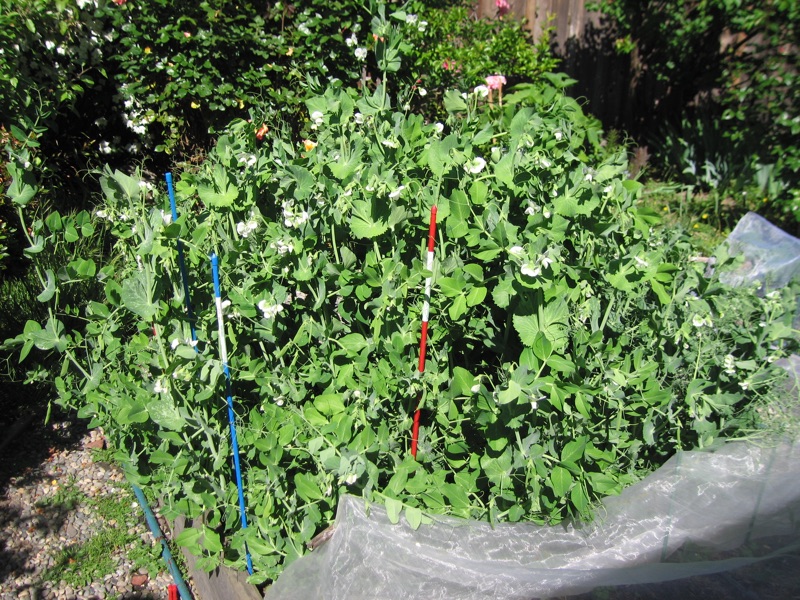
For a few weeks in May, they produced so many peas that I ended up giving a lot away. The quality of our peas has been very high season after season for the past few years that I have been growing them. I would rank sugar snap peas near the top of my list of produce that is most worth growing at home. The pea pods are very crisp and flavorful, especially when compared to the taste and freshness of store bought sugar snap peas that I have purchased. And I can’t say that about all home grown produce. My home grown potatoes, for example, have not tasted different than store bought potatoes, although they were fun to grow and pesticide free.
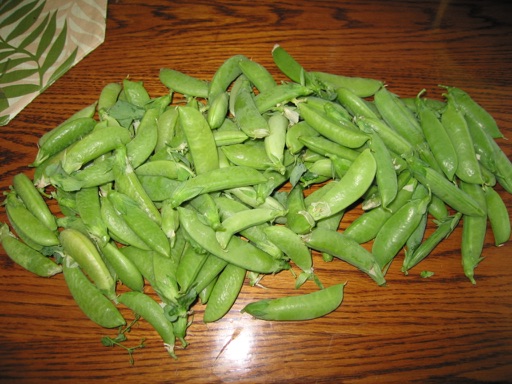
February 27 2018 | Peas and Pluots | Comments Off on Late Winter Garden
We have 3 cherry trees growing in our backyard. They are about 8 years old. The varieties are Bing, Rainier, and Royal Rainier. In previous years, I have found maggots inside some of the cherries. Last year, most of the cherries were infested with maggots, especially on the Royal Rainier. I noticed small flies buzzing around the fruit. I suspected that the flies were spotted wing drosophila (SWD). Most of the cherries were brown and inedible looking from the insect damage. I ended up throwing all of them away.
I was on the verge of removing all of our cherry trees, because I didn’t want to implement a spraying regime. I had the same problem with raspberries in the past. I sprayed the raspberries back then, but it didn’t help. I ended up removing all of my raspberries. But I wasn’t ready to give up on the cherries just yet. It has taken several years for them to reach the size they are and to start producing fruit. Also, removing the cherry trees now would require much more work than removing raspberries.
So this year I tried something different. I have netted the cherry trees with bird netting in past years to keep birds away, but the holes in bird netting are too large to keep out insects. The only type of netting I am aware of that has a mesh fine enough to keep out small flies is mosquito netting. So earlier this year, I bought some mosquito netting.
After our cherry trees were out of bloom in mid-April, I wrapped mosquito netting around our Royal Rainier cherry tree and tied it with twine around the trunk. I then rolled any open parts of the netting together and sealed the openings with clothes pins to keep insects from flying or crawling in. It helped that I have pruned this tree to keep it under 8 feet tall. I didn’t bother to net the other two cherry trees, because they set very few cherries this year. Here is what our tree looks like netted.
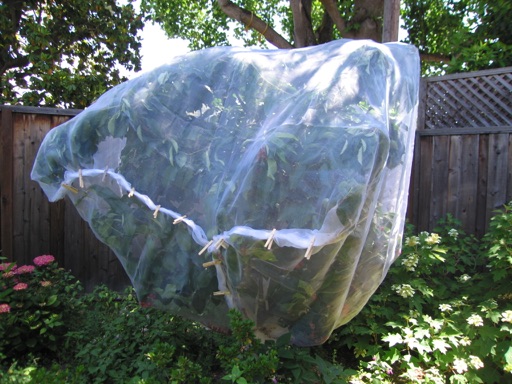
Last weekend, I harvested most of the Royal Rainier cherry crop. Here’s what they looked like inside the tree.
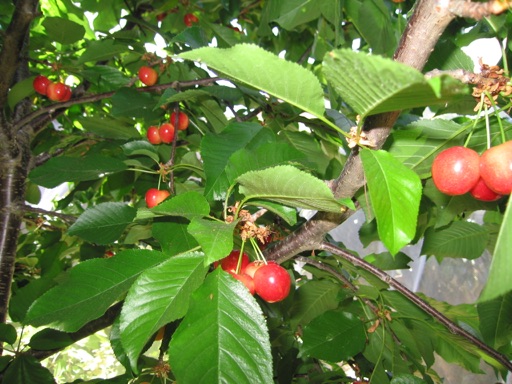
And here is what they looked like after harvest.
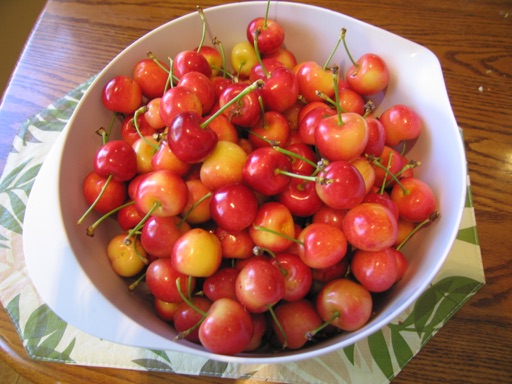
They look beautiful and taste amazing. Not one of the cherries appears to have been touched by birds or insects. We have eaten most of them already, and we haven’t found maggots in any of them. The netting also allowed me to leave the cherries on the tree long enough to fully ripen.
Netting a tree is extra work, and it is probably not practical for large trees over 10-12 feet tall. However, I think it was worth the effort. Mosquito netting is easier to work with than bird netting, because it doesn’t get caught on things as easily. And it keeps out all kinds of pests including insects, birds, and squirrels.
In fact, I am so happy with the results of the mosquito netting that I am using it to cover some of my other fruits and vegetables. For example, I am using it to cover broccoli and cauliflower to keep out cabbage moths and aphids. I am also using it to cover my blueberry bushes as shown below. Even though the netting has a fine mesh, it appears to be letting in enough sunlight for these plants to remain healthy and grow.
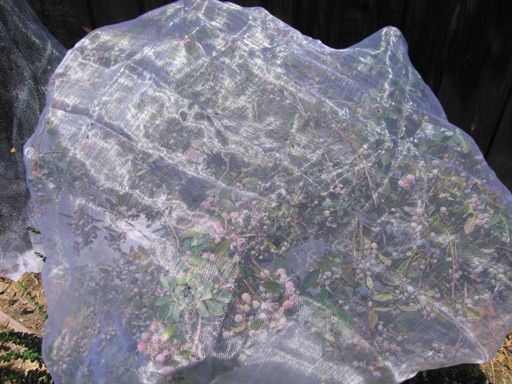
June 08 2017 | Blueberries and Cherries | Comments Off on Mosquito Netting
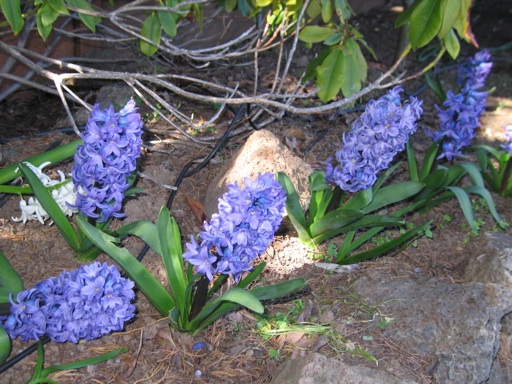
The blue hyacinths we planted last fall are already in bloom. Weeds were nearly obscuring them until I weeded around them a few weeks ago. Now they are stand outs in our front yard.
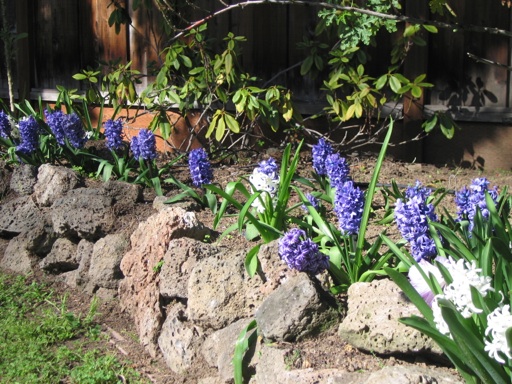
Some of our fruit trees are already in bloom this month. Below is a new arctic blaze nectarine tree I bought last year that is now blooming for the first time. My previous attempts at growing white nectarines ended in failure when the entire crop cracked and rotted, apparently from over watering. Subsequent under watering led to dead trees. This time, I am growing one in a pot to ensure better drainage.
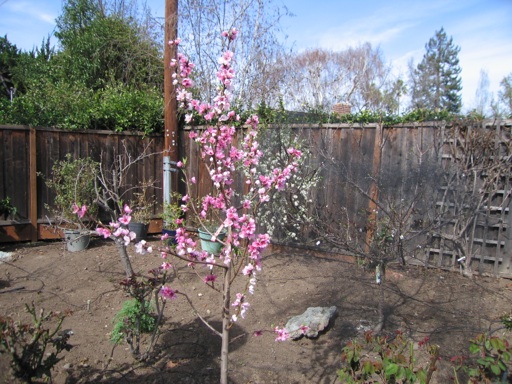
Below is our new loring peach tree, also in bloom for the first time. I bought it last year after our O’Henry peach died a few years ago.
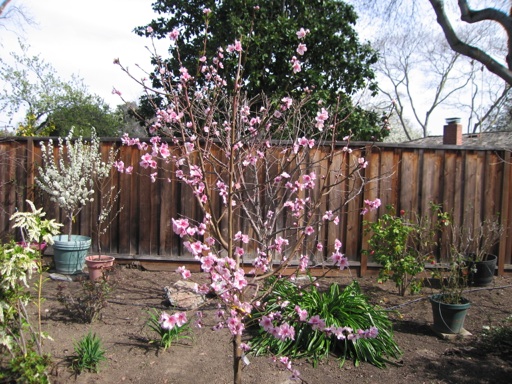
This flavor king pluot tree is another new fruit tree that I bought last year. I am also growing it in a pot due to lack of space (too many fruit trees). It bloomed last year, but it did not set any fruit – possibly a pollination issue. Now, I have a super-pollinator (santa rosa plum) growing in a pot to the right of it.
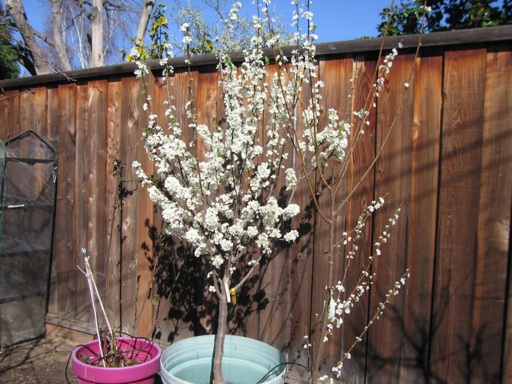
Our multi-grafted pluot tree is also in bloom (below). One of the grafts is also flavor king. Flavor king is our favorite pluot, perhaps my favorite fruit, which is the reason I bought one tree that only has a flavor king graft on it.
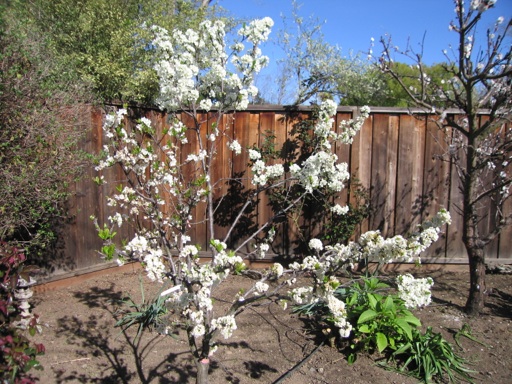
February 26 2016 | Hyacinths and Peaches/Nectarines and Pluots | Comments Off on Early Blooms
Our multi-grafted Japanese plum tree is full of plums right now. It’s a very small tree, about 5 feet tall and 4 feet wide. But it has over 100 plums on it. It has the most densely packed fruit of any fruit tree we have. It would benefit from thinning, because the branches can break under the weight of the fruit, but I didn’t bother to thin this year, because the fruit set was not as heavy as last year. The main grafts are the varieties Elephant heart and Laroda, which is the dark purple fruit in the picture below.
The tree also has a graft of Nubiana, which is very small and doesn’t grow much, and Beauty. Most of the Beauty graft broke off two years ago under the weight of a heavy load of fruit. I cut off the remaining branches of Beauty, because I didn’t care for its flavor. The Elephant Heart and Laroda grafts are not self-fruitful, but both have managed to set a lot of fruit two seasons in a row without pollen from Beauty. Pollen from our pluot tree and a neighbor’s plum have probably helped. The Beauty graft was huge and on the verge of taking over the tree. The Elephant Heart and Laroda grafts have grown a lot since Beauty has been gone.
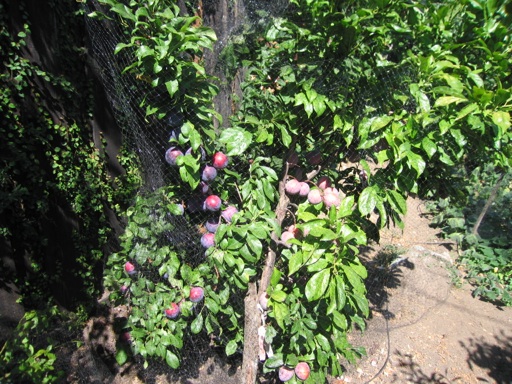
I really enjoy growing sugar pie pumpkins and butternut squash. I have found that they are both easy to grow from seed as long as they get regular water. I planted several groups of seeds last March. The vines are very long now and have set many fruits, even though I haven’t fertilized them. The vines can take up a lot of space, which is why I planted the seeds where the vines can grow in between our fruit trees. I planted them directly in the ground, not in our raised beds, because the vines would just grow out of the beds and across our paths between the beds. Some of the pumpkins have even grown roots directly from the vines into the ground.
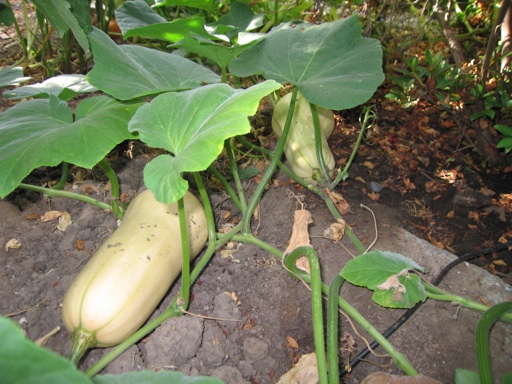
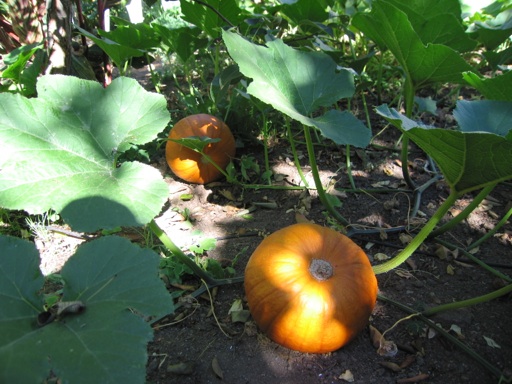
We are also growing Siam Queen (Thai) basil this year. I planted the seeds in pots in our mini-greenhouse in April and transplanted the seedlings into one of our raised beds in May. They only grow in warm weather, and it can get cold in April here. The plants grew slowly at first, but they are now starting to grow more rapidly. Their leaves have a strong scent that is similar to licorice, and their flowers are an attractive purple color. Also, they don’t seem to attract insects.
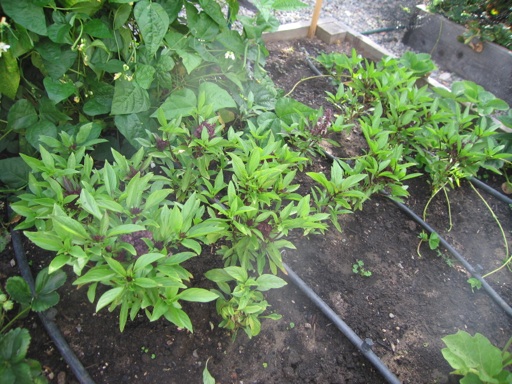
Our purple Dahlias have been full of flowers for several weeks. We are also growing them in raised beds where they get plenty of water and rich composted soil. Unfortunately, they are already getting mildew on their leaves, which happens every year around this time.
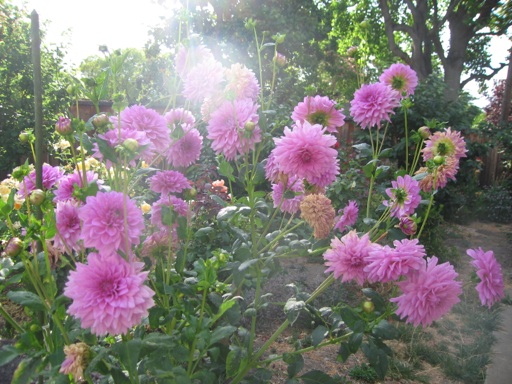
I planted corn seeds in mid-March this year, which is the earliest I have ever planted them. We almost never get frost here after March 1. I planted the peaches and cream variety, and ended up with about 18 plants. I always plant at least 15 corn seeds in a planting to ensure proper pollination. I started harvesting corn ears the first week of this month. They were very tasty.
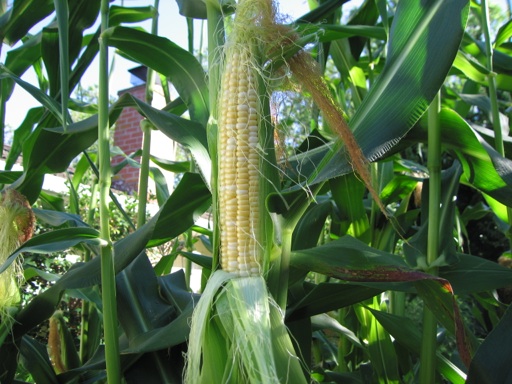
I harvested some of the last ears today. Several of the stalks had two ears, and a few stalks grew outshoots that themselves grew an additional ear of corn. I have more corn in another bed that I planted in June. They should be ready to harvest in October.
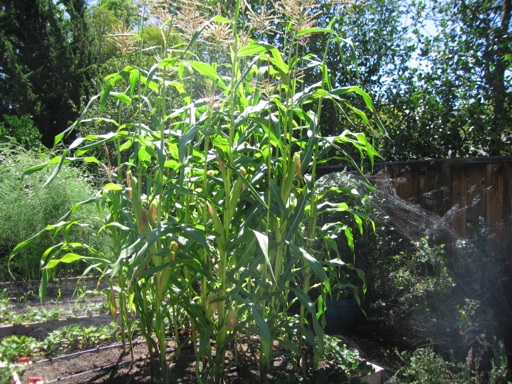
I planted Albion strawberries in pots with potting soil in May. I had not grown this variety previously. I have been picking strawberries from the Albion plants for over a month now, and they have exceeded my expectations. They have been continuously producing very sweet and large berries. They are much sweeter than Chandler, which are on the tart side in our yard. I think I will be planting more Albion strawberries in the future. So far the Albion plants have not produced many runners, unlike our Sequoia strawberries, which are prolifically producing runners right now.
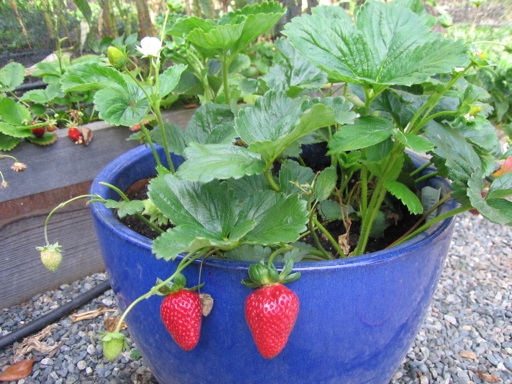
July 26 2014 | Basil and Corn and Dahlias and Plums and Pumpkin and Squash and Strawberries | Comments Off on Mid-summer post
Our strawberry harvest started the second week of April, which is very early for our area. But, their growth and fruit production started to slow down around mid-May. At that point, I realized that our strawberry plants weren’t getting enough water from my automatic sprayers. For the past few weeks, I’ve been watering them by hand nearly everyday, and they seem to be responding to the extra water.
Our strawberry plants are now growing again and getting new flowers. In the past, I’ve thought that fertilizing regularly was the key to getting lots of strawberries for many months. But now I’m realizing, they just need lots of water, preferably a daily soaking.
Below is a picture of some of our Chandler strawberries growing in a pot. Chandler is one of my favorite varieties, because it produces large strawberries on strong stems. I have also been growing Sequoia strawberries for years.
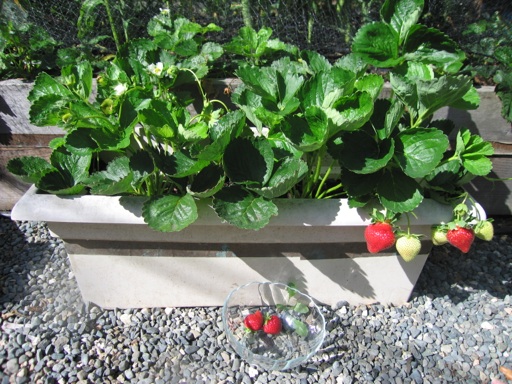
Last week, I planted some everbearing Albion strawberries, which I hope will produce berries in mid and late summer after the June bearing varieties are finished. This is a variety that I haven’t grown before.
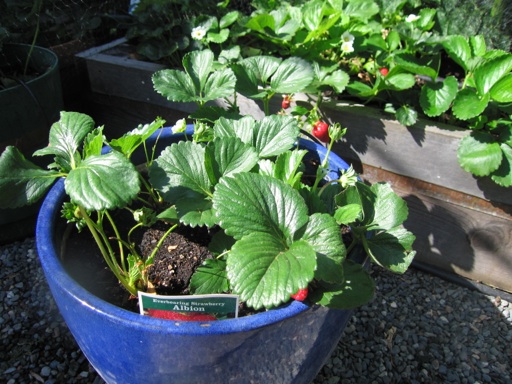
I’ve also been harvesting cherries from our Rainier and Royal Rainier cherry trees this past week. The Royal Rainer cherries are very sweet and mild (picture below). Our Royal Rainier tree has produced cherries nearly every year we’ve had it, which is about 5 years now. It has consistently produced more fruit than our other two cherry trees, even though it is smaller than our other cherry trees.
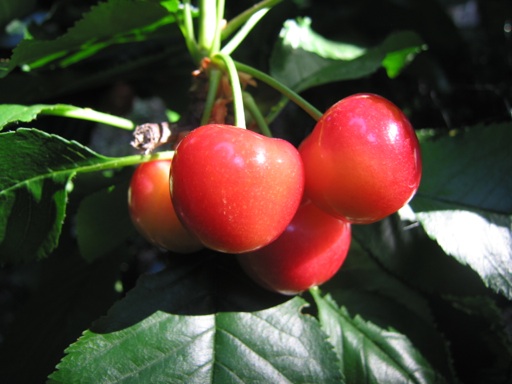
Our Rainer cherries are more tart, even though the tree is a year older than the Royal Rainer and visually the cherries look very ripe. Also, the tree doesn’t have many cherries, and this is the first year it has had more than 2 cherries. However, our Rainier tree is a very vigorous grower. It has grown to about eight feet tall and as wide despite regular pruning as shown below.
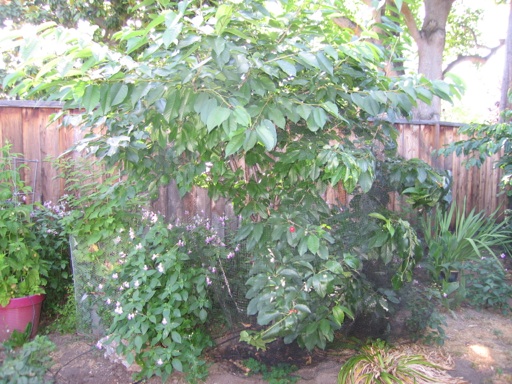
Our third cherry tree is a Bing, which also has its first significant crop of cherries this year. Its fruit is just starting to get a deep red color. I’m leaving the fruit on the tree, until they get nearly black. And of course, I have bird netting on all three trees. So far, it has prevented even a single cherry from being pecked at, as far as I can tell.
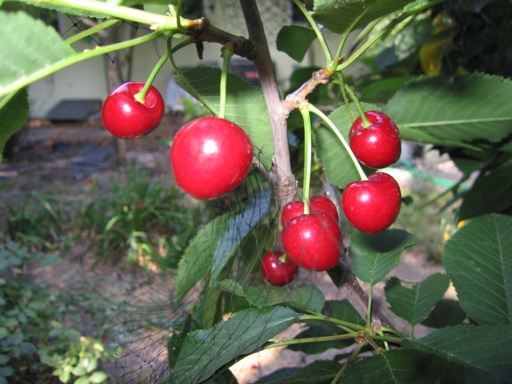
Our blueberry harvest also started the second week of April, which is about a month earlier than usual. I was picking blueberries from our Misty plant in April and early May. Moving it to a sunnier location and the warm weather we had this spring seem to be the reasons for the early harvest. I also currently have the blueberry varieties Southmoon, Sunshine Blue, Jubilee, Reveille, Sharpblue, and O’Neal. These others starting ripening around mid-May, and they still each have many underripe berries left on their branches. I have all 7 of our blueberries in pots, and they seem to be thriving in them as long as I keep them well hydrated. They definitely dry out faster in the pots than in the ground. Below is a photo of a few of the blueberries that are growing next to a fence, which makes it easier to net them.
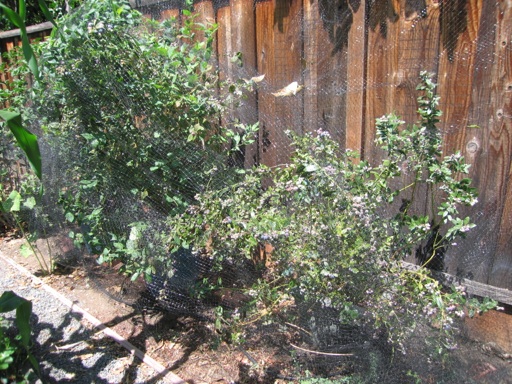
And here is what the same plants looked like in bloom on March 2.
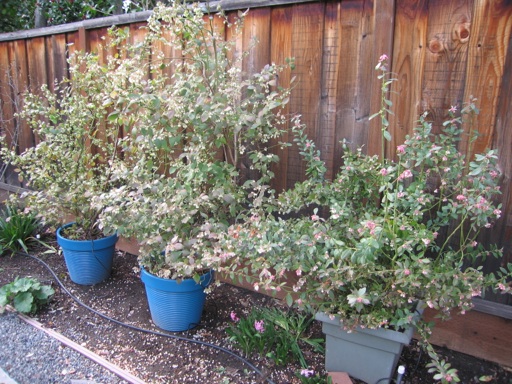
I harvested so many blueberries this week that I had enough to make a blueberry pie and still had some left over.
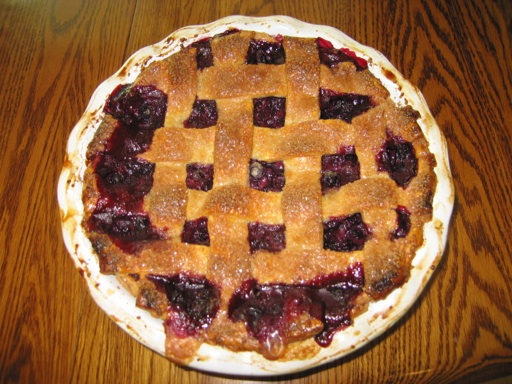
June 06 2014 | Blueberries and Cherries and Strawberries | Comments Off on Berries and Cherries
Next »





























